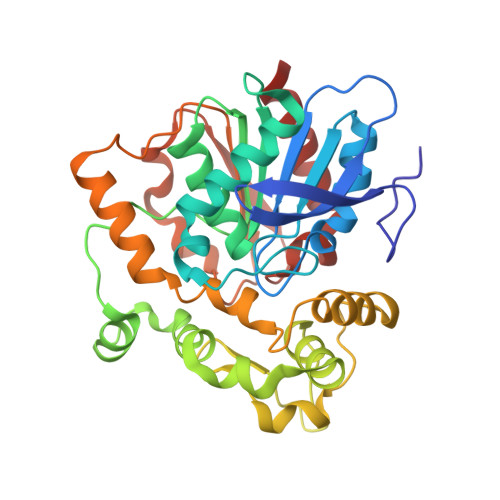Structure of a soluble epoxide hydrolase identified in Trichoderma reesei.
Wilson, C., De Oliveira, G.S., Adriani, P.P., Chambergo, F.S., Dias, M.V.B.(2017) Biochim Biophys Acta 1865: 1039-1045
- PubMed: 28502798
- DOI: https://doi.org/10.1016/j.bbapap.2017.05.004
- Primary Citation of Related Structures:
5URO - PubMed Abstract:
Epoxide hydrolases (EHs) are enzymes that have high biotechnological interest for the fine and transformation industry. Several of these enzymes have enantioselectivity, which allows their application in the separation of enantiomeric mixtures of epoxide substrates. Although two different families of EHs have been described, those that have the α/β-hidrolase fold are the most explored for biotechnological purpose. These enzymes are functionally very well studied, but only few members have three-dimensional structures characterised. Recently, a new EH from the filamentous fungi Trichoderma reseei (TrEH) has been discovered and functionally studied. This enzyme does not have high homology to any other EH structure and have an enatiopreference for (S)-(-) isomers. Herein we described the crystallographic structure of TrEH at 1.7Å resolution, which reveals features of its tertiary structure and active site. TrEH has a similar fold to the other soluble epoxide hydrolases and has the two characteristic hydrolase and cap domains. The enzyme is predominantly monomeric in solution and has also been crystallised as a monomer in the asymmetric unit. Although the catalytic residues are conserved, several other residues of the catalytic groove are not, and might be involved in the specificity for substrates and in the enantioselectivy of this enzyme. In addition, the determination of the crystallographic structure of TrEH might contribute to the rational site direct mutagenesis to generate an even more stable enzyme with higher efficiency to be used in biotechnological purposes.
Organizational Affiliation:
Department of Microbiology, Institute of Biomedical Science, University of São Paulo, São Paulo, Brazil; Programa de Pós Graduação em Microbiologia, IBILCE-UNESP, São José do Rio Preto, São Paulo, Brazil.















